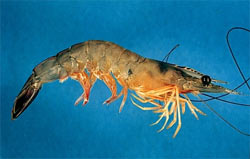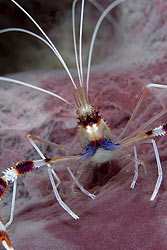Shrimp and Prawns are swimming, decapod crustaceans. Shrimp, widely distributed around the world in both fresh and salt water, belong to the group Caridea, . Adult shrimp are filter feeders living close to the bottom. Many live in schools and can swim rapidly backwards. Shrimp are an important link in food webs, providing food for larger animals from fish to whales.
Most Prawns belong to the group Penaeidae. In common usage, the terms "shrimp" and "prawn" are often used interchangeably. Shrimp and Prawns look very similar but can be distinguished by the fact that In shrimp the side plate of the second segment of the abdomen overlaps the segments in front and behind. In prawns all the abdominal side plates overlap tile-like from the front. Also the gill structure is branching in prawns. Another difference is that female prawns do not brood eggs but relase them into the water. |

|
Common shrimp species include pink, brown and snapping shrimp. They grow from about 1.2 to 30 centimetres long, and live between one and 6.5 years. Some shrimp have a claw almost as large as the carapace whilst others have slender and delicate ones. The eyes are on mobile stalks each side of the rostrum (a projection of the carapace between the eyes) and above the long antennae.
The male mates with the female after she has moulted and her body is soft. Within a day the female produces eggs which are then fertilized then the female shrimp lay 50,000 to 1 million eggs which go through a number of larval stages taking about 12 days from hatching. These small adults then migrate into estuaries, which are rich in nutrients and low in salinity, where hey grow and eventually migrate back into open waters when they mature.
References
http://en.wikipedia.org/wiki/Shrimp
http://en.wikipedia.org/wiki/Prawn
http://museumvictoria.com.au/crust/caribiol.html |

|